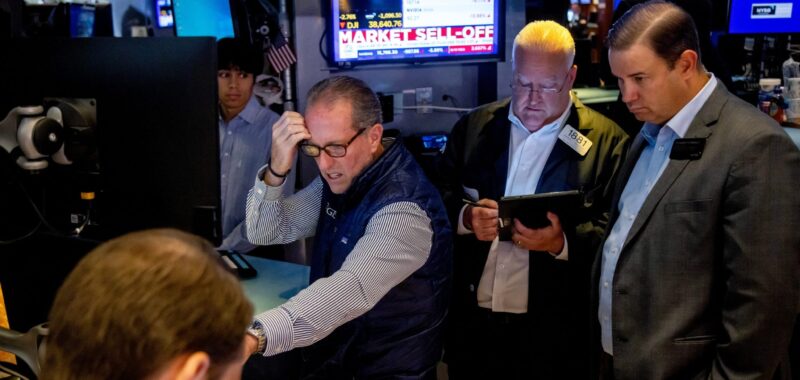
Wall Street’s infamous ‘fear gauge’ surged on Monday, hitting its highest level since 2020 as stocks around the world tumbled.
The CBOE Volatility Index, or VIX, measures the implied volatility of the S&P 500 over the next 30 days based on market pricing for options. A higher value on this ‘fear gauge’ signals more expected volatility (think: rapid stock price changes) and overall uncertainty ahead.
The VIX surged to a peak of 65.70 on Monday morning, before paring some of its gains to sit at 36 as of 11:30 am EST. That’s still up from just over 23 on Friday, and just 12 at the start of the year.
The VIX hit a peak of over 85 in March 2020 in the wake of COVID-19 lockdowns.
Monday’s spike came as the Dow Jones Industrial Average sank 2.5%, while the S&P 500 fell 2.6%, and the tech-heavy Nasdaq Composite plummeted 2.9%.
Paul Christopher, head of global investment strategy at Wells Fargo Investment Institute, cited several reasons for the market’s dismal showing and rising investor fear on Monday in a note to clients seen by Fortune. A mix of earnings disappointments among some tech and consumer-focused companies, escalating tensions in the Middle East, and recent data that has shown broadening weakness in the economy are all to blame, he said.
After repeatedly surprising experts with its resilience, the U.S. economy has recently shown signs of a sharp slowdown. The July employment report came in far weaker than anticipated last week, with the U.S. economy adding 114,000 jobs, compared to economists’ consensus forecast for 175,000. The unemployment also rose to 4.3%, triggering one of the most accurate recession indicators, the infamous Sahm Rule.
“The immediate implication is that investors fear that the economy may weaken rapidly and want the Fed to cut rates aggressively to maintain economic growth,” Wells Fargo’s Christopher explained.
However, the global stock market rout began in Japan on Monday, where the Nikkei 225 plunged 12% in its worst day since 1987. And some say the so-called “carry trade” may be to blame for Japan’s dark Monday.
For years, traders have borrowed money in Japan, where interest rates are low, and then used that money to buy assets abroad. But with the Bank of Japan now raising interest rates last week, and most Western nations lowering interest rates, that trade isn’t what it used to be.
“[T]his market volatility is mostly a global carry trade unwind and a re-evaluation of the AI hype,” Jim Smigiel, chief investment officer at SEI, which manages, advises, or administers approximately $1.5 trillion in assets, told Fortune via an emailed statement.
Smigiel pointed to the ISM services report, which measures activity in 15 non-manufacturing industries in the U.S., as evidence that the current market sell-off isn’t based entirely on recession fears. The ISM Services purchasing managers index registered 51.4% in July, indicating the sector expanded for the 47th time in 50 months. That’s far from the typical reading in a recession.
Smigiel said he expects the two-to-three 25-basis-point rate cuts from the Fed through the rest of the year amid the current market turmoil, but he argued against an emergency intra-meeting rate cut, like the one proposed by Wharton Professor Jeremy Siegel on Monday.
“Quite frankly, this sell-off is now overdone. Emergency Fed rate cuts being priced in makes little sense given the economic backdrop in the U.S. and would only serve to destroy policy maker credibility,” he argued.

